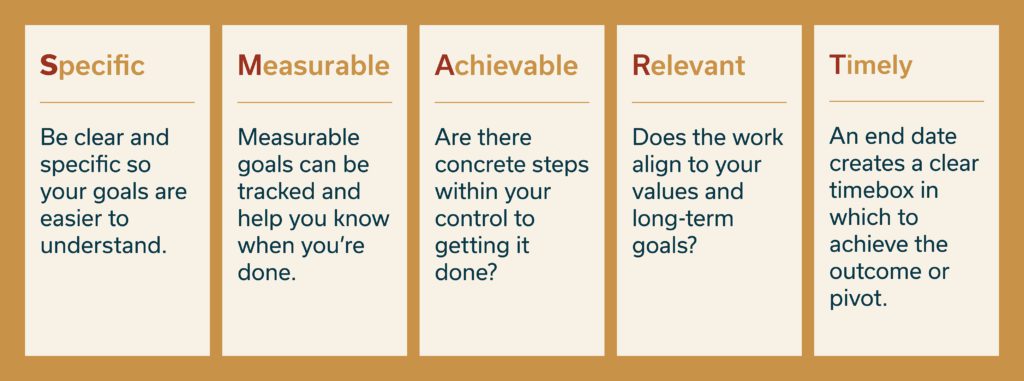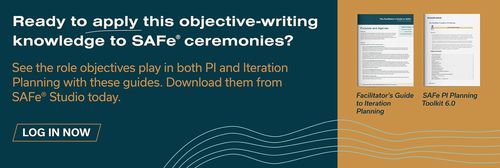
Agile is disciplined; not reckless.
Writing useful Iteration Goals and Planning Interval (PI) Objectives requires focus and discipline to achieve proper agility transformation. Bad objectives are one of the most common reasons organizations stop using them. This guide will help you write objectives that get results.
For simplicity, I will use “objectives” interchangeably when talking about iteration goals and PI objectives. Iteration goals are a scaled-down version of PI objectives, which means you can apply my guidance to both metric types.
Why We Write Iteration and PI Objectives
Before you can write effective iteration and PI objectives, you must understand why we write them. It’s common for organizations to treat objectives as summaries of the features or stories teams commit to in the PI or iteration. But that is a misunderstanding of the objectives’ purpose.
Objectives represent the Agile Team’s commitment to delivery in the PI or iteration. They create a feedback loop from the business to the team. This loop ensures both parties understand the organizational vision:
- Teams can confirm their understanding of the business’s desired outcomes
- The business can clarify or further refine its value priorities
During an iteration or PI Planning, teams neither commit to all the features brought to PI Planning nor to whole features. So it’s important to understand what outcomes the features create. This gives everyone a chance to weigh in on those outcomes.

How PI Objectives Support PI Planning
At PI Planning, the business gives its prioritized feature list to the Agile Release Train (ART). Then, teams on the ART sequence their stories and features based on their priorities and capacities.
During this process, teams will only commit to a subset of the business requests. PI objectives ensure teams commit to the proper subset of the business’s requests. Business value scores and conversations with business owners and key stakeholders also support team commitments.
Teams can then sequence stories and features into a delivery plan that leads to business outcomes. They communicate this plan through the objectives and summarize the business and technical goals in language the business understands. It’s much more than a summary of the planned work.
Another benefit of well-written objectives is they create an opportunity for alignment. Teams should be able to connect their features and stories to the highest value objectives. This makes it easier for the team(s) to see if they’re doing the most valuable work first. If not, they need to address priorities or technical dependencies.
How PI Objectives Are Evaluated by Business Owners
Besides understanding what objectives are for, we must also consider who objectives are for.
Teams write iteration and PI objectives for the Business Owners and key stakeholders. Teams do not write objectives for the Product Managers and Product Owners (POs) who manage the backlogs. The Product Managers and POs know what work they asked for.
Objectives communicate which business outcomes the team contributes to and why they matter. Teams then understand the deeper purpose behind their work, thus helping employee engagement.
Business Owners evaluate PI objectives at the end of the PI to help the ART measure its performance and business value achieved. This helps determine ART predictability.
One caveat to note: uncommitted objectives do not count towards a team’s predictability measure. Therefore, it’s important to write uncommitted objectives during PI planning to demonstrate that the team plans to complete the work but understands there are factors out of their control that may prevent them from delivering the value named in the objective.
Near the end of PI planning, the Business Owners assign a business value to each PI objective. The business value is a number between 1 (lowest) and 10 (highest). Business Owners quantify the value of PI objectives through a conversation with the team. To determine the business value, they consider questions like
- Is the work customer-facing?
- Will the work improve future velocity and value delivery?
- When will the value be delivered?
- How much of the organization will contribute to the objective?
- How large will the impact be if the objective is not completed in the PI?
Once the PI is over, Business Owners assign Actual Business Value to the PI objectives. Actual Business Value is the amount of value that was delivered toward the objective in the PI.
For example, if one of your objectives was assigned a business value of 7, Business Owners will decide based on the team’s completed work how many of the 7 points were delivered. Like in PI planning, the scores are determined through conversations between the team and Business Owners.
The structure of your PI objectives impacts how smoothly the Actual Business Value assignments go. Well-structured and clear objectives help Business Owners and teams easily measure what was delivered in the PI. The tips in the following sections outline how to write objectives Business Owners and teams will understand.
How to Write Meaningful Iteration and PI Objectives
Now that we’ve identified what objectives are and who they’re for, let’s inspect some PI objective examples from the field.
- Implement Jenkins
- Build 2 APIs
- Build a database
- Design a template
These examples do not effectively communicate the business outcomes the work produces. Additionally, these example objectives are written solely from the perspective of development or engineering teams and have no connection to why the work matters. If the objectives just restate the names of the features, they are a waste of time and energy.
Let’s review how to write objectives that create a meaningful connection between the technical work and the business.
First, all objectives should be S.M.A.R.T.

Second, a good objective has five components that effectively communicate a business outcome and why it matters:
- Activity: What will we be doing?
- Scope: What are the boundaries of the work we will touch?
- Beneficiary: Who is the intended recipient of the new work?
- User Value: Why does this work matter to the new user?
- Business Value: Why does this work matter to the business?
Examples of each component include:
- Activity: Create, Implement, Define, Design, Enable, Modify, Etc.
- Scope: App, API, Mobile, Web, Database, Dashboards, Etc.
- Beneficiary: Customer, End-user, System Team, Mobile Users, Etc.
- User Value: Faster, Better, Cheaper, Enhanced, New Features, Etc.
- Business Value: Reduced Call Times, Increased Sales, Increased Data Efficacy, Reduced Loss to Fraud, Etc.
You can put these two steps together using the following formula.
![PI Objective Formula
[Activity] + [Scope] so that [Beneficiary] have [User Value] to [Business Value]](https://scaledagile.com/wp-content/uploads/2022/11/SAi_Blog_Header_PI_Formula_103122-1-1024x244.jpg)
Iteration and PI Objectives Examples from the Field
Here are a few examples of good iteration and PI objectives from three different contexts.
Financial services company example
- Activity: Add
- Scope: three new methods of e-payment
- Beneficiary: so that mobile users with digital wallets
- User Value: have an improved checkout experience
- Business Value: to drive a three-percent revenue increase
“Add three new methods of e-payment so that mobile users with digital wallets have an improved checkout experience to drive a 3 percent revenue increase.”
Digital transformation team example
- Activity: Create
- Scope: an Agile Ways of Working guide
- Beneficiary: so that {Company} employees
- User Value: have clear guidance on implementing Agile behaviors
- Business Value: to enable a faster flow of value with higher quality delivery
“Create an Agile Ways of Working guide so that {Company} employees have clear guidance on implementing Agile behaviors to enable faster flow of value with higher quality delivery.”
An example from a team building a new customer data platform
- Activity: Create
- Scope: a single source of truth customer database
- Beneficiary: so that customers who call us
- User Value: have an improved customer experience
- Business Value: with a 25 percent shorter time to resolution
“Create a single-source of truth customer database so that customers who call us have an improved customer experience with a 25 percent shorter time to resolution.”
Using the above approaches creates a powerful statement of business value. And it creates greater alignment between the teams’ work and business strategy. Tip: teams can write their objectives using the bulleted format to make them even clearer.
Find More Objectives Resources in SAFe® Studio
Iteration and PI objectives create feedback loops between the teams and the business. They also assess how well the team’s work aligns with organizational goals. When you understand this connection, you can improve your implementation of these objectives.
If you have objective-writing stories, good or bad, in your organization, share them with me. Together, we can improve this process for everyone.
Objective-writing resources in SAFe® Studio:
- Tactical Tuesday: Iteration Goals and PI Objectives podcast
- Measuring Business Value – PI Objectives Overview video
- Smarter S.M.A.R.T. Objectives video
- Shared Objectives and Collaborative Sense-Making: Key to Success blog
- Assigning Business Value During PI Planning video

About Saahil Panikar

Saahil is a SAFe® Practice Consultant Trainer (SPCT) and certified Enterprise Business Agility Strategist. He is determined to help organizations extend their Agility beyond IT. He started his career as a Data Scientist, and Saahil is still passionate about the metrics behind successful transformations. As a former collegiate rugby player for the University of Florida, Saahil bleeds Orange and Blue and is a die-hard fan of Gator Football.


